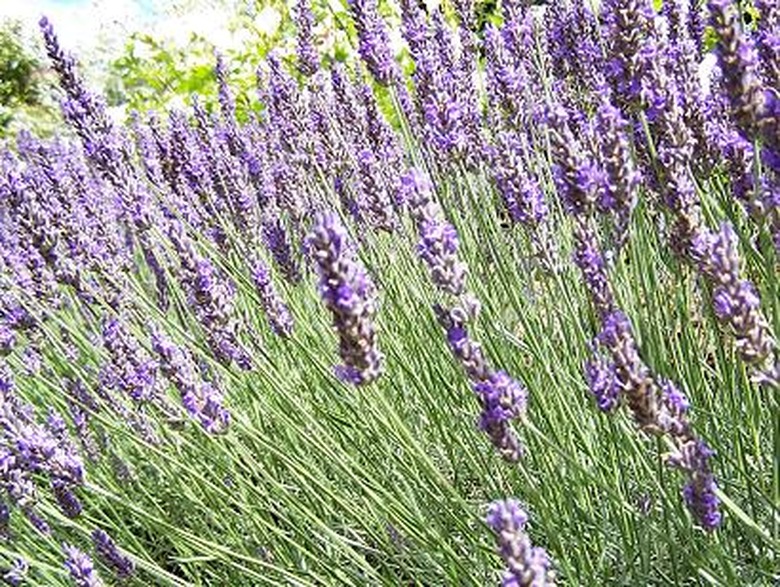How To Extract Lavender Oil From A Lavender Plant
Things Needed
- Large stockpot
- Concave stockpot lid or heavy-duty aluminum foil
- Glass measuring cup
- Clean flat brick or stone, large enough to set cup on
- Fresh lavender
- Water
- Stove
- Ice cubes
- Separating funnel (optional)
Tip
Try a practice pot of water to see if your lid works correctly. You can fine-tune the placement of the cup and how much ice to use. Resist the temptation to open the steam chamber (pot) while it is working. The condensation will fall into the pot of water instead of the collection cup. Save the scented water from the cup to use as mister scent to spritz on towels or sheets. Instead of using a piece of brick, you can layer the chopped herb in the bottom of the pot, then place an open-basket vegetable steamer on top of the lavender and the cup in the steamer. Be sure the steamer basket will not tip as the herb softens during steaming.
Warning
Pure essential oil can be strong and should be diluted in a carrier.
Use steam distillation to extract oil from lavender at home. The steam passes through the herb, picking up tiny droplets of the plant oil. The steam carries the droplets upward, contacting a concave lid, where the oil-laden droplets condense, cool and fall into a collection vessel. The resulting oil is pure essential oil of lavender, which you can blend with carrier oils or ointments. The extracted essential oil-to-water ratio will be approximately 1:25 using this method.
Prepare the Herb
Step 1
Cut lavender sprigs. The oil content is highest just before the flowers open.
- Use steam distillation to extract oil from lavender at home.
- The resulting oil is pure essential oil of lavender, which you can blend with carrier oils or ointments.
Step 2
Wash the lavender in cool water. Strip leaves, flowers and soft stems. Discard stems with woody bark.
Step 3
Chop leaves, flowers and soft stems together into pieces about 1 to 2 inches long.
Set up the Distiller
Step 1
Center the piece of flat brick in the bottom of the stockpot.
Step 2
Set the measuring cup upright on the piece of brick.
Step 3
Fill the stockpot with chopped lavender all around the brick. The lavender should be at least 3 to 4 inches deep, a little deeper than the thickness of the brick.
- Wash the lavender in cool water.
- Fill the stockpot with chopped lavender all around the brick.
Step 4
Add enough water to cover the lavender.
Step 5
Cover the pot with a concave lid turned upside down so that it curves inward. If a lid like this is not available, you can use a stainless-steel bowl with a rounded bottom that covers the stockpot. You can also use two or three layers of heavy-duty aluminum foil to create the shape, and bend the edges to seal the foil around the lip of the stockpot. The idea is to have a collection surface above the cup where the oil-laden droplets of steam can condense. The surface needs to be curved inward to channel the droplets so they drip into the measuring cup.
Process
Step 1
Heat the stockpot until the water just begins to boil gently. Reduce the heat to simmer, just enough to maintain steam.
- Add enough water to cover the lavender.
- The surface needs to be curved inward to channel the droplets so they drip into the measuring cup.
Step 2
Place a few ice cubes in the upside-down lid or bowl. Cooling the lid in this manner creates a better atmosphere for the steam to condense on the inside of the lid. Replenish the ice as needed, and remove water from the melted ice.
Step 3
Keep the pot steaming for three to four hours.
Separate the Essential Oil
Step 1
Turn off the stove. Allow the pot to cool slightly, so you can handle the measuring cup. Tap the lid gently to shake off the last droplets into the measuring cup before opening the pot. Allow the cup and contents to cool.
- Place a few ice cubes in the upside-down lid or bowl.
- Allow the pot to cool slightly, so you can handle the measuring cup.
Step 2
Separate the oil using a separating funnel, if you have one. A layer of essential oil will be floating on top of the condensed water in the cup. Another method is to skim off the layer of essential oil. You can freeze the liquid, watching for the point where the water is just frozen and the oil is still liquid and can be poured or scraped off.
Step 3
Pour the essential oil into small bottles. Store them at room temperature in a dark cupboard.
